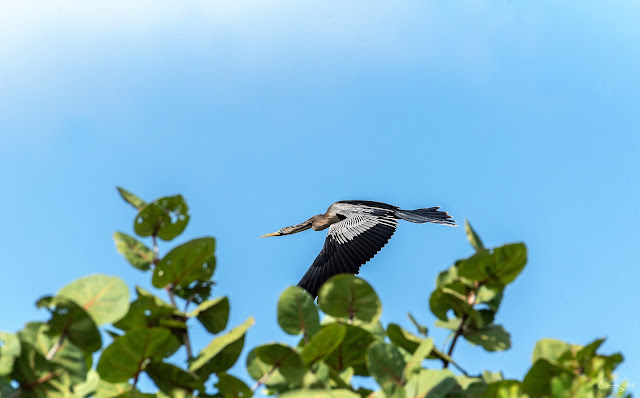I went searching for the osprey's nest. The osprey that kept, on an almost daily basis, flying onto the rooftop of the condo across from ours.
I figured if he was flying in and out of our area, he was then residing somewhere close.
So a hunting I went.
In my search I did find his nest.
But because I came across this beauty, the osprey's nest became secondary in it's imporatance (I did evenetually find the nest and it will show up at some later post) and instead I concentrated on grabbing a few photos of this long necked bird called Anhiga.
"The anhinga sometimes called snakebird, darter, American darter, or water turkey, is a water bird of the warmer parts of the Americas. The word anhinga comes from the Brazilian Tupi language and means "devil bird" or "snake bird". The origin of the name is apparent when swimming: only the neck appears above water so the bird looks like a snake ready to strike. They do not have external nares (nostrils) and breathe solely through their epiglottis.
The anhinga is placed in the darter family, Anhingidae, and is closely related to Indian (Anhinga melanogaster), African (Anhinga rufa), and Australian (Anhinga novaehollandiae) darters. Like other darters, the anhinga hunts by spearing fish and other small prey using its sharp, slender beak."
He/she was perched on one of those trees which by itself was also very photogenic, but I was more interested in the beauty of this bird.He was way up there, but luckly I had my 200-500mm lens with me and was able to get close enough without disturbing.
Anhingas and Cormorants are very similar in looks. They, just like Cormorants do not have oil glands because their feathers are not water repellent. This benefits both species by allowing them to move easier underwater while foraging.Perhaps the most easily identifiable difference between the two birds is their bill shape. Anhingas have straight, long, bils as opposed to Cormorants curved, hooked, bill In addition, Anhingas have longer tails and small, white markings on their backs.
I clicked from every possible angle I could get to from way down there until I noticed he was getting ready to take off.
Hence, I turned on burst mode and followed as best as I could.
Obviously, lost him in the trees but was really happy to have had the opportunity to capture a portrait or two. 😊
(source)
(source)
































Excellent work! It's hard to stay on something at that angle with such a large lens for that long - you are to be commended, my Queen!👑
ReplyDeleteThank you John. It was such a unique bird that I had to force myself to stick with him.
DeleteBeautiful shot. I had forgot that they are also considered water turkeys as a common name. One fun thing is they will fall into the water like a rock when they are startled if they are drying their wings while in a tree.
ReplyDeleteMaybe I'll get lucky next time and see one drying and watch him fall 😁. I know that would be cruel but it could end up being a great shot.
DeleteWhat a find. This is wholly new to me and quite beautiful. As you say Cormorant shaped but ours are just black. Great shots especially in flight. My Dad hated Cormorants, he was a fisherman and just saw them as competition.
ReplyDeleteThank you. I really got lucky and I am glad I have photos of this guy in my collection.
DeleteGreat shots. Like Gethin I have never heard of these and I understand the cormorant being disliked by fishermen. I have heard of a few stories where cormorants get to a lake and hunt so successfully they decimate the fish population.
ReplyDeleteIn your first image the bird seems so well camouflaged in the tree.
Easy to understand why you had to stop and take these images.
Thank you David for your comments. It was my first encouonter with this type of bird, sheer luck.
Delete